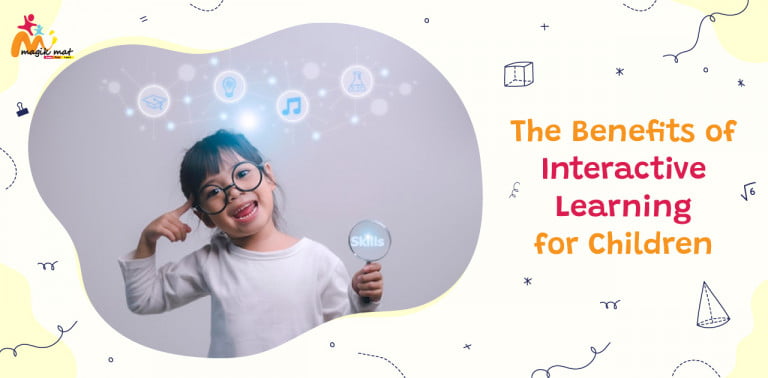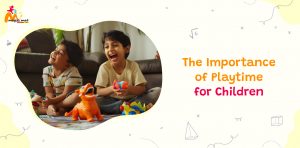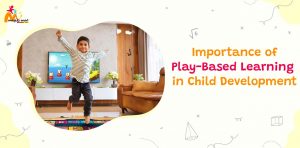Nowadays, kids spend a lot of time on their smartphones, which prevents them from engaging in physical activities and developing their brains. Children of this generation are, as we can see, hyperactive and advanced, making it easy for them to adopt new technologies. Numerous products are available that can support kids in learning in an enjoyable method that enhances their development through both physical and mental activities.
When kids are vigorously engaged in the activity-based learning process and educational games, they are more likely to receive feedback on their progress. This can help them identify areas of strength and areas that need improvement. Additionally, interactive learning often involves hands-on activities, which can help children see the immediate results of their efforts and adjust their approach as needed.
Interactive learning is becoming increasingly important for today’s children as it allows them to actively participate in their own education and prepares them for success in the 21st century.
Experiential learning is a powerful tool for children, as it engages them in a way that traditional methods of teaching may not. There are several benefits to interactive learning for children, including improved understanding and retention of information, increased motivation and engagement, and the children’s development of critical thinking and reasoning skills.
Interactive learning allows children to actively participate in the learning process, rather than simply listening to a teacher or reading from a textbook. Involving children in interactive activities, simulations, and learning games helps them better comprehend and retain the information they are learning. This is because children can connect the information and their experiences, which helps solidify their understanding.
Children require a joyful and engaging environment for learning. Interactive learning can be a great way for children to learn new concepts and skills. It emphasizes imagination, creativity, and enthusiasm and ignites a passionate desire and readiness to learn new things in kids. When they perceive that the activity will be enjoyable, they are more likely to listen to the instructions, participate, and effectively comprehend the learning principles. Additionally, it allows for collaboration and the exchange of ideas among kids, which can lead to a deeper understanding of the concepts & topics they learn. It also allows for immediate feedback and adjustments to the learning process, which can lead to a more personalized and effective learning experience.
Overall, interactive learning can be a powerful tool for improving student engagement, understanding, and success.
Self-directed learning activities often involve hands-on, experiential learning, which can help children see the relevance and application of what they are learning in the real world. This will boost their confidence and will spark a genuine interest in the subjects and concepts they are learning.
One such Edutech product is Magik Mat, which is an integrated collection of fantastic, animated games that have been carefully designed, with simple controls that are suitable for children. It has been reviewed and approved by child development experts.
As the name suggests, it is a kid-friendly mat with elements that are nearly magical. It achieves the ideal balance between enjoyment and education. The mat is attractively printed with the alphabet, numbers to boost math skills such as addition and subtraction, and shapes on both sides. Children can remember, play, learn and grow with the help of interactive gaming and learning device with a plethora of learning games and unique features.
Through interactive learning children can develop the skills like Recognition of letters and numbers, analysis, and the building of attention span, colour and shape recognition, creativity and imagination, Developing Curiosity, timing and pattern recognition, speaking abilities, general knowledge, and memory improvement. In addition to all the learning, the Interactive learning approach offers a platform for children to play while they study, encouraging them to engage in physical activity.
The interactive education approach also increases motivation and engagement among children, as they are more likely to be interested in a subject when they are actively involved in it. This can lead to greater participation and enthusiasm in the classroom, which can ultimately lead to better academic performance.
Below are some key benefits of interactive learning for children:
- Improved Understanding and Retention: Interactive learning allows children to actively participate in the learning process, rather than simply listening to a teacher or reading from a textbook. By involving children in engaging activities, simulations, and games, practical learning helps them to better understand and retain the information they are learning.
- Increased Motivation and Engagement: Interactive learning increases motivation and engagement among children, as they are more likely to be interested in a subject when they are actively involved in it. This can lead to greater participation and enthusiasm in the classroom, which can ultimately lead to better academic performance.
- Critical Thinking, Problem-Solving, and Skill Development: Interactive learning helps to develop critical thinking and problem-solving skills among children. Encouraging children to experiment, explore, and find solutions to problems helps them to develop the skills they need to succeed in school and life.
- Flexibility and Adaptability: Interactive learning allows children to learn at their own pace and in their own way. It provides a range of learning opportunities and options that can be tailored to each child’s individual needs and learning style. This helps children to be more flexible and adaptable in their learning.
- Creativity and Innovation: Personalized learning encourages creativity and innovation among children. It provides opportunities for children to think outside the box and come up with new and unique ideas.
- Teamwork: Active learning also helps children to develop teamwork skills. Many interactive learning activities require children to work together to complete a task or solve a problem. This helps children to learn how to communicate, collaborate, and work well with others.
As a whole, Interactive learning helps to develop discerning thinking and problem-solving skills among children. By encouraging children to experiment, explore, and find solutions to challenges, interactive learning helps them in boosting skill development to succeed in school and life. Additionally, interactive learning also helps children to develop creativity, teamwork, and a growth mindset.





